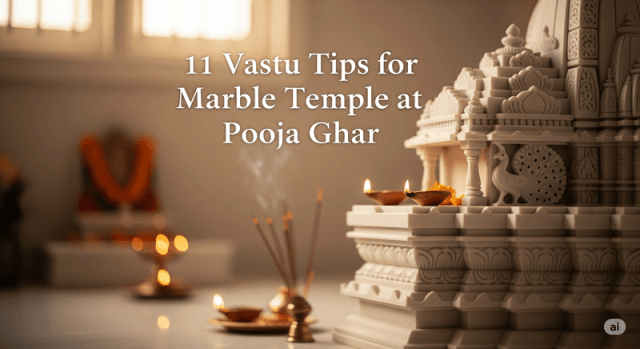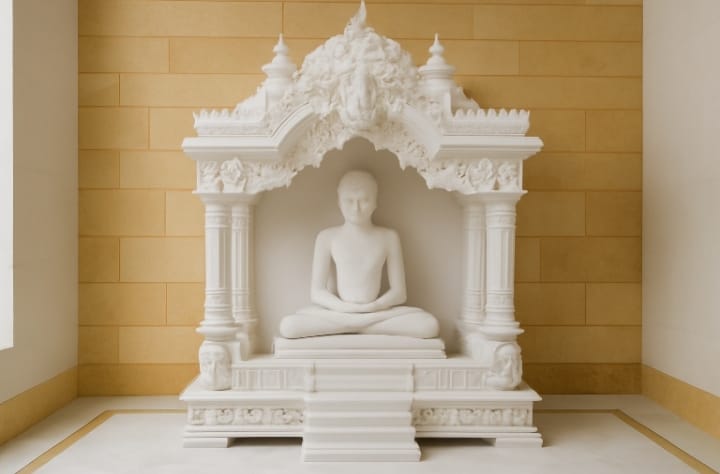Creating a Sacred Space: Vastu Tips for Marble Temple in the Pooja Ghar

The pooja ghar, or home temple, is a sanctuary for spiritual connection, a place where we seek peace and offer our prayers. Installing a marble temple within this sacred space not only adds aesthetic beauty but, according to Vastu Shastra, can also significantly influence the flow of positive energy. Marble, with its inherent purity and elegance, is a favored material for home temples. To ensure your marble temple aligns with Vastu principles and enhances the spiritual ambiance of your home, consider these detailed guidelines:
1. The Auspicious Direction: Welcoming Positive Energies
Vastu emphasizes the importance of directionality in harnessing cosmic energies. For your pooja ghar and, consequently, your marble temple, the northeast (Ishan Kon) is considered the most sacred and highly recommended direction. This corner is believed to be the entry point for divine energies.
- Primary Choice: Northeast: Ideally, your entire pooja room should be located in the northeast of your home. Within this room, placing your marble temple against the east or north wall is optimal.
- Alternative Auspicious Directions: If the northeast is not feasible, the east or north directions are also considered auspicious for the pooja ghar and the placement of the temple.
- Direction of Deities: The idols or images within your marble temple should ideally face east or west. This orientation allows the person offering prayers to face either north or east, both considered positive directions for receiving divine blessings. Avoid placing deities facing south.
2. Height and Visibility: Establishing a Reverent Connection
The height at which your marble temple is installed plays a crucial role in fostering a respectful and meaningful connection with the divine.
- Ideal Height: Position your marble temple in such a way that the deities are at chest level when you are standing or at eye level when you are seated for prayer. This ensures a posture of reverence and facilitates a direct gaze upon the sacred images.
- Avoid Ground Level: Never place the idols directly on the floor. The elevated platform of a marble temple inherently addresses this.
3. Purity and Order: Maintaining a Divine Atmosphere
Cleanliness and order are paramount in a pooja ghar, as they contribute to the purity and sanctity of the space.
- Keep it Pristine: Regularly clean your marble temple and the surrounding area. Marble’s smooth surface makes it easy to maintain.
- Clutter-Free Zone: Avoid accumulating clutter around or, importantly, beneath the marble temple. Do not store any unnecessary items, especially footwear, under the temple. This can obstruct the flow of positive energy.
4. Illuminating the Divine: The Role of Light
Light symbolizes knowledge and positivity. Ensuring your pooja ghar and marble temple are well-lit is essential.
- Natural Light: If possible, position your pooja ghar where it receives ample natural light, especially during the morning hours.
- Artificial Lighting: Supplement natural light with soft and devotional artificial lighting. Consider using lamps, diyas (oil lamps), or strategically placed light fixtures to create a serene and uplifting ambiance around your marble temple.
5. The Serenity of Marble: Choosing the Right Color
The color of the marble used in your temple can also influence the energy of the space.
- Favored Colors: White or off-white marble is highly recommended for pooja ghar temples. These colors symbolize purity, peace, and spiritual clarity.
- Other Suitable Options: Light shades of yellow or cream marble are also considered auspicious and can bring a warm and inviting feel to the space.
- Avoid Dark Colors: Refrain from using marble in dark or very intense colors for your pooja temple, as these can potentially introduce negative energy.
6. Idol Placement: Respecting the Sacred Forms
The placement of idols within your marble temple should also adhere to Vastu principles to maintain harmony.
- Well-Maintained Idols: Ensure that the idols or images you place in the temple are in good condition – not broken, cracked, or faded.
- Distance from the Wall: Position the idols a few inches away from the back wall of the temple. This allows for proper air circulation and creates a distinct presence for the deities.
- Avoid Facing Each Other: Do not place idols directly facing each other within the temple.
- No Overcrowding: While you may have multiple deities you revere, avoid overcrowding the temple space. Maintain a sense of order and reverence.
By thoughtfully considering these Vastu tips when installing your marble temple in your pooja ghar, you can create a truly sacred and energetically positive space that enhances your spiritual practices and brings peace and harmony to your home. Remember that the intention and devotion you bring to your worship are paramount, and these Vastu guidelines serve as supportive principles to amplify the positive energies within your personal sanctuary.




